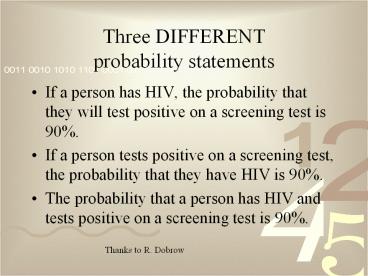Three DIFFERENT probability statements - PowerPoint PPT Presentation
1 / 7
Title:
Three DIFFERENT probability statements
Description:
Three DIFFERENT probability statements If a person has HIV, the probability that they will test positive on a screening test is 90%. If a person tests positive on a ... – PowerPoint PPT presentation
Number of Views:70
Avg rating:3.0/5.0
Title: Three DIFFERENT probability statements
1
Three DIFFERENTprobability statements
- If a person has HIV, the probability that they
will test positive on a screening test is 90. - If a person tests positive on a screening test,
the probability that they have HIV is 90. - The probability that a person has HIV and tests
positive on a screening test is 90.
Thanks to R. Dobrow
2
Conditional Probability
- P(AB)
Event of interest
Conditioning Event
Given
The probability that A occurs given that B occurs
3
Confusing conditional probabilitiesThe
Prosecutors FallacyA case study People vs.
Collins
- On June 18, 1964, Juanita Brooks was attacked in
an alley near her home in LA and her purse stolen - A witness reported that a woman running from the
scene was blond, had a pony tail, dressed in dark
clothes and fled from the scene in a yellow car
driven by a black man with a beard and mustache - Police arrested a couple, Janet and Mark Collins,
which fit the description
4
People vs. Collins
- During 7-day trial, prosecution ran into
difficulties - Juanita Brooks could not identify either
defendant - Witness admitted at a preliminary hearing that he
was uncertain of his identification of Mr.
Collins in a police lineup - Math instructor at a state college took the stand
as an expert witness - Was asked, What is the chance that Mr. and Mrs.
Collins are innocent given that they match the
descriptions of the perpetrators on all six
characteristics? - The expert witness testified that the probability
of a combination of characteristics, or their
joint probability, is given by the product of
their individual probabilities
5
People vs. Collins
- The prosecution provided the following
probabilities - Prosecution multiplied these probabilities to
claim that the probability that a randomly
selected couple would have all these
characteristics was 1 in 12 million - Prosecutor concluded that the chance that the
defendants were innocent was only 1 in 12 million - The jury convicted the Collinses of second-degree
robbery.
Evidence Probability
Girl with blonde hair 1/3
Girl with ponytail 1/10
Partly yellow car 1/10
Man with mustache 1/4
Black man with beard 1/10
Interracial couple in car 1/1,000
6
People vs. Collins
- Defense appealed and the California Supreme Court
reversed the conviction on four grounds - The probabilities lacked evidentiary
foundation. They were merely estimates. - Multiplying the six probabilities assumes
independence, for which there is no proof - The prosecutor assumed that the six
characteristics were certain - Most importantly, there was a fundamental flaw in
the prosecutors reasoning
7
The Prosecutors Fallacy
- Prosecution inferred that the probability of
observing a match in all six characteristics is
the probability that the Collinses were innocent. - This is known as the prosecutors fallacy
- P(Match) ? P(Innocent Match)
- Suppose the match probability was correct
- Suppose the reference population is 24 million
couples in California and one of them is guilty - If P(Match) 1/12 million, we would expect two
couples to match - P(Innocent Match) P(Innocent and Match) /
P(Match) (1/24 million) / (1/12 million) 1/2































